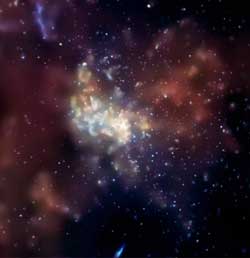Milky Way monster stars in cosmic reality show

Chandra X-ray Observatory Image of Sagittarius A* <br> <br>
This Chandra X-ray Observatory image of the supermassive black hole at the Milky Way’s center, a.k.a. Sagittarius A* or Sgr A*, was made from the longest X-ray exposure of that region to date. In addition to Sgr A* more than two thousand other X-ray sources were detected in the region, making this one of the richest fields ever observed.
During the two-week observation period, Sgr A* flared up in X-ray intensity half a dozen or more times. The cause of these outbursts is not understood, but the rapidity with which they rise and fall indicates that they are occurring near the event horizon, or point of no return, around the black hole. Even during the flares the intensity of the X-ray emission from the vicinity of the black hole is relatively weak. This suggests that Sgr A*, weighing in at 3 million times the mass of the Sun, is a starved black hole, possibly because explosive events in the past have cleared much of the gas from around it.
Evidence for such explosions was revealed in the image – huge lobes of 20 million-degree Centigrade gas (the red loops in the image at approximately the 2 o’clock and 7 o’clock positions) that extend over dozens of light years on either side of the black hole. They indicate that enormous explosions occurred several times over the last ten thousand years. Further analysis of the Sgr A* image is expected to give astronomers a much better understanding of how the supermassive black hole in the center of our galaxy grows and how it interacts with its environment. This knowledge will also help to understand the origin and evolution of even larger supermassive black holes found in the centers of other galaxies.
NASA’s Marshall Space Flight Center in Huntsville, Ala., manages the Chandra program. (NASA/CXC/MIT/F.K.Baganoff et al.)
Media Contact
More Information:
http://www1.msfc.nasa.gov/NEWSROOM/news/photos/2003/photos03-002.htmlAll latest news from the category: Physics and Astronomy
This area deals with the fundamental laws and building blocks of nature and how they interact, the properties and the behavior of matter, and research into space and time and their structures.
innovations-report provides in-depth reports and articles on subjects such as astrophysics, laser technologies, nuclear, quantum, particle and solid-state physics, nanotechnologies, planetary research and findings (Mars, Venus) and developments related to the Hubble Telescope.
Newest articles

Webb captures top of iconic horsehead nebula in unprecedented detail
NASA’s James Webb Space Telescope has captured the sharpest infrared images to date of a zoomed-in portion of one of the most distinctive objects in our skies, the Horsehead Nebula….

Cost-effective, high-capacity, and cyclable lithium-ion battery cathodes
Charge-recharge cycling of lithium-superrich iron oxide, a cost-effective and high-capacity cathode for new-generation lithium-ion batteries, can be greatly improved by doping with readily available mineral elements. The energy capacity and…

Novel genetic plant regeneration approach
…without the application of phytohormones. Researchers develop a novel plant regeneration approach by modulating the expression of genes that control plant cell differentiation. For ages now, plants have been the…





















